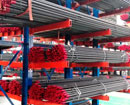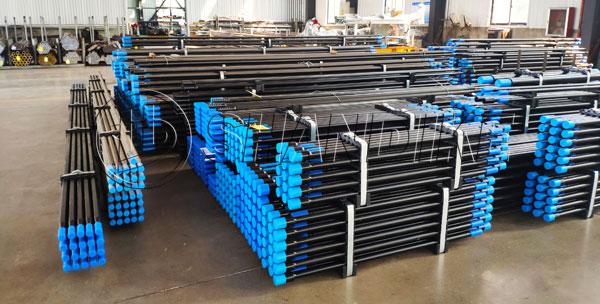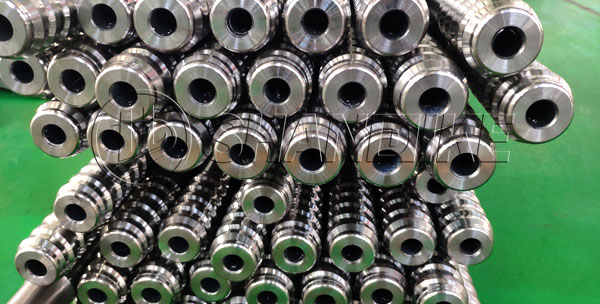Solutions
-

- Drilling Tools T38 3660Mm MM
Drilling Tools T38 3660Mm MM MF Thread...
-

- Hex22 Pneumatic Rock Drilling Tool
Small Hole Drillig Tools Hex22 7/11/12 Degrees Tools Taper Drill Rod...
Detailed introduction, usage, and maintenance of DRIFTER DRILL ROD
Date: 2024-11-01 From: SDK Author: admin
DRIFTER DRILL ROD, also known as drift drill rod, is mainly used for rock drilling operations in mining, especially in tunnel excavation and drift drilling operations.
 1、 Detailed Introduction
1、 Detailed Introduction
Name and alias
Official name: DRIFTER DRILL ROD
Alias: Drift drill rod, tunnel steel, tunnel rod, etc
Structural characteristics
Drift drill rods usually come in two body shapes: circular and hexagonal. The hexagonal body is more rigid, heavier, and has higher energy transfer efficiency, while also increasing the flushing effect.
One end of the drill rod is usually designed as the driving end, used to connect with a rock drill to accommodate larger diameters and handle adapters, increasing strength.
Specifications and types
Drift drill rods come in various specifications and types, such as R25, R32, R38, etc., each corresponding to a different length and diameter.
The length range varies from a few hundred millimeters to several thousand meters to accommodate different drilling depths and operational requirements.
Heat treatment and performance
Drifting drill rods undergo two heat treatment methods (carburizing and intermediate frequency induction surface quenching) to enhance their overall quality and performance, and extend their service life.
2、 Usage method
preparation
Check if the drill rod is intact, including the shaft, drive end, and connecting parts.
Ensure that the rock drill is in good working condition and matches the specifications of the drill rod.
Connection and installation
Align the drill rod drive end with the connection part of the rock drill and insert it.
Use appropriate tools or equipment to secure the drill rod to the rock drill, ensuring a secure and reliable connection.
Homework operation
Start the rock drill and begin the rock drilling operation.
Adjust the speed, pressure, and feed rate of the rock drill according to the homework requirements.
During the homework process, pay attention to observing the working status of the drill rod and rock drill, and promptly detect and handle any abnormal situations.
3、 Maintenance methods
Daily inspection
After each assignment, conduct a visual inspection of the drill rod, including whether there are cracks, wear, or damage to the shaft, drive end, and connecting parts.
Check if the connection between the rock drill and the drill rod is loose or damaged.
Cleaning and lubrication
Regularly clean the dirt and dust on the surface of the drill pipe to keep it clean and dry.
Lubricate the parts that require lubrication, such as connecting parts, bearings, etc., to reduce wear and friction.
Storage and Preservation
Store the drill rod in a dry, ventilated, and non corrosive gas environment, avoiding prolonged exposure to sunlight or humid conditions.
Avoid stacking drill rods with other heavy or sharp objects to prevent damage to their surfaces or connecting parts.
Regular maintenance and replacement
Regularly conduct a comprehensive inspection of the drill pipe, including whether there are cracks, wear, or corrosion inside the shaft.
If serious wear, damage, or performance degradation of the drill pipe is found, it should be replaced or repaired in a timely manner.
In summary, DRIFTER DRILL ROD is an important tool in mining operations, and its detailed introduction, usage, and maintenance methods are all crucial. Only by using and maintaining drill pipes correctly can they ensure long-term stable operation and optimal performance.
There are various models of DRIFTER DRILL ROD, which are mainly distinguished based on their specifications, sizes, uses, and manufacturers.
Classified by specifications:
R25: Refers to a certain specification or size of drill rod, usually matching specific rock drilling or operational requirements.
R32: Similar to R25, but may differ in size or performance, suitable for different work environments.
R38, T38, T45, T51, etc.: These models also represent different specifications or sizes, suitable for different rock drilling operation needs.
Classified by shape:
Circular drill rod: usually lightweight, easy to operate, suitable for operations that require frequent replacement of drill rods or long-distance drilling.
Hexagonal drill rod: With higher rigidity and strength, as well as higher energy transfer efficiency, it is suitable for work environments that require higher strength and stability.
Classified by purpose:
Drift drill rod: mainly used for tunnel excavation, drift drilling and other operations, capable of transmitting large impact energy and torque.
Extended drill rod: used to increase drilling depth, usually used in conjunction with drift drill rods.
Guided drill rod: It has a special guiding function to ensure the accuracy and directionality of drilling.
Classified by manufacturer:
Different manufacturers may produce DRIFTER DRILL RODs with their own unique designs and specifications. These models may include manufacturer identification, serial number, production date, and other information.
In addition, there are some special DRIFTER DRILL ROD models, such as MF drill rods (Male Female Rod), speed drill rods, etc., which may have more complex structures and higher performance requirements.
Previous:How to choose Pionjar 120 drill rod?
Next:none
